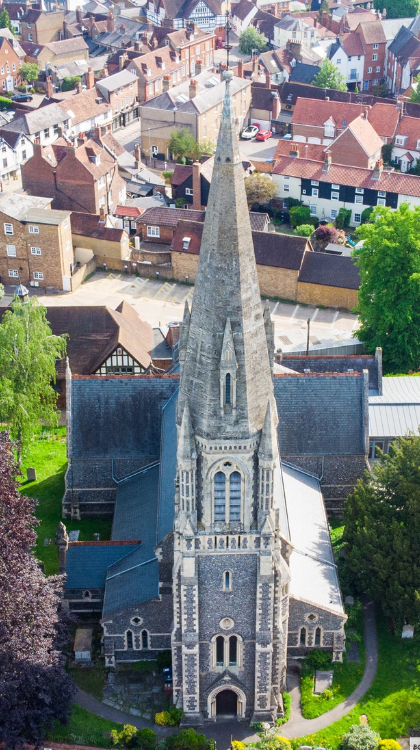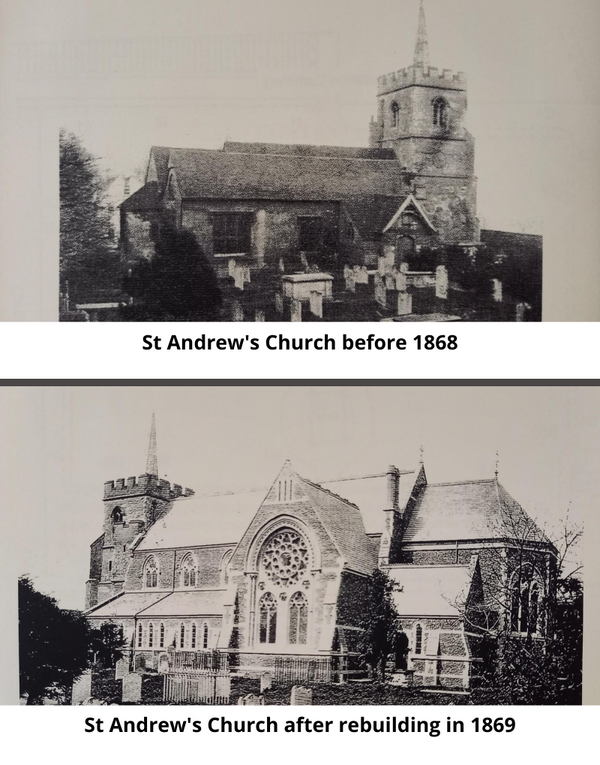
Our history
St Andrew’s is in the Diocese of St Albans (previously it was in the Diocese of Rochester and, before that, in the Diocese of Lincoln). The Monarch, through the Duchy of Lancaster, is the patron of the living of 'Hertford St Andrew, with St Nicholas and St Mary'. You can follow the link to a map showing the parish boundaries as held by the Church Commissioners.
A church of St Mary stood until the early 16th Century on the old site of the public library at Old Cross. St Nicholas Church stood in Maidenhead Yard (behind Maidenhead Street). During the 16th Century, the population decreased and both churches fell into disuse; they were closed and the parishes annexed to St Andrew's early in the 18th Century.
From Hertford Castle westward, the parish comprises the centre of the town bounded by the River Beane to the north and the Rivers Lea and Mimram to the south. Beyond the housing estates of Sele Farm and Hertingfordbury Road it is bounded to the west by the rural parishes of Waterford, Tewin, Bramfield and Hertingfordbury. The total population of the parish is around 7500.
The History of the Building
 The Rev. Canon R. H. Gill A.K.C., rector of the parish from 1952-1970, did a great deal of research and he compiled a short illustrated history and guide book, published in 1957 and re-issued in 1970 and 1995. This is the source of the present summary, together with information gathered from other church records.
The Rev. Canon R. H. Gill A.K.C., rector of the parish from 1952-1970, did a great deal of research and he compiled a short illustrated history and guide book, published in 1957 and re-issued in 1970 and 1995. This is the source of the present summary, together with information gathered from other church records.
The origin and date of St Andrew’s is not certain but some authorities believe it is the original church of Hertford, the parish being created in 860 AD. There is some evidence that a small wattle-and-daub church existed, destroyed by the Danes in 894 AD. This was succeeded, possibly in the 12th Century, by an apsidal church built of flint, plastered over, and consisting of a Nave, Chancel and North and South aisles. This was rebuilt in about 1480.
In the 17th Century the Communion Table, which had stood in the Chancel, was moved back to the East Wall and enclosed with rails by order of Archbishop Laud. A three-decker pulpit was added. The Nave and Chancel were filled with high box pews allocated to local families according to their importance. The poor occupied rough benches at the back.
In the 18th Century there were various alterations and additions to the pews; in 1786 the Hertford Corporation paid £20 to the churchwardens for a pew to be reserved for their use. The font was of oak. There was a gallery on the North side of the church and an organ gallery at the west end.
By the 19th Century the church was dilapidated and described as cold, damp and depressing; it could seat only between 200-300 people of a parish of 2,200. In 1851 the North Road cemetery was consecrated as there was no longer room for burials in St Andrew’s churchyard. It was suggested that the building should be demolished and a new church built.
The present building was consecrated on 24 March 1870. It cost £4,000 and was built in nine months. The tower was added in 1875 and the bells re-hung at a cost of about £2,000.
The most recent, major renovation work on the building was completed in 2018 with significant funding received from the Heritage Lottery.
A full history of the town can be found at Hertford Museum.
St Nicholas’ Hall (most recently known as 'Beckwith’s')
In 1887, to celebrate their 250th anniversary, grateful townsfolk of Hartford, Connecticut, sent a gift of £115.11s to St Andrew’s as thanks for information supplied about their ancestors who left Hertford for the New World in 1637. Further fundraising enabled them to purchase the site of St Nicholas’ Hall, with the cottages in front, from the Marquess of Salisbury. The hall was officially opened on Wednesday 5 April 1893. The architect was Edgar T. Wigram ARIBA of Lupus Street, London SW, and the builders were Messrs Ginn & Son of Hertford. In November 1900 the new Verger, Mr Cheshire, took up residence in the part of the renovated cottages at the front of St Nicholas’ Hall. It was sold to Beckwith’s (an antiques company) in 1970 and they kept the premises until 2018. The premises are now occupied by Brothership Beckwiths.
St Andrew's School
The St Andrew’s School started in an old tithe barn adjacent to the eastern end of the church in about 1845. The barn was demolished in 1863 and eleven years later an Infant School was built on the Hertingfordbury Road/Warehams Lane corner. A Junior School was added in 1882. It continued to serve the town until 1962 when the last phase of a new building was completed for St Andrew's C of E Primary School at Calton Avenue, Sele Farm. The church school continues to flourish on that site. Hertford St Andrew C of E Primary School
Further information